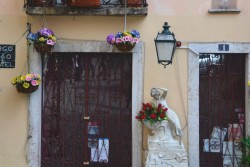
It’s tempting to think that Portugal wouldn’t be very different from neighboring Spain. Spain’s all that surrounds Portugal after all, apart from a few hundred kilometers of Atlantic coastline along its western expanse.
The itinerary for my most-recent trip was less than logical. After arriving to Spain from Morocco, I’d travel to Switzerland then to Holland before ending up in Portugal. Thanks to a mess up on the part of Iberia, Spain’s flag carrier, I ended up connecting through Lisbon en route from Marrakech, Morocco to Barcelona, giving me a preview of Portugal several weeks before I actually got there.
I knew as the plane descended over Lisbon’s perfect red-orange roof tiles that I would return to a place that was very different from anywhere I’d ever been – Spain, Holland, or elsewhere. In spite of its small size and being mostly encircled by Spain, Portugal has managed to maintain an identity all its own, one that reveals itself through architecture, culture, and lanscape.

After my plane landed in Lisbon, my friend Alex picked me up and we went to have a drink near the Lisbon waterfront behind the Vasco da Gama mall. More impressive to me than the waterfront, the mall or relics from the World Expo Lisbon hosted in 1998 was the Oriente Railway Station, the largest in Lisbon and in all of Portugal. The station’s unique and beautiful design set it apart from anywhere else I’d been and reflected a winning combination of sophistication and innovation.

Alex lives in a town called Cascais, located about 30 minutes’ north of Lisbon by car. I spent my second day in Portugal exploring the historical town of Sintra, a hilltop village adorned with charming buildings that range in age from 100-500 years. My favorite of these was the Quinta da Regaleira estate, located about 10 minutes’ walking from the historical center of the city. Built in 1892 by a rich family of merchants from Porto, the estate has a magical, otherworldly air that was made all the more so by the intermittent rain that fell the day I visited.

My third stop in Portugal was the city of Porto, the country’s second-largest, located in northern Portugal in the Duoro River valley near the Atlantic Ocean. Although the portion of the city immediately around the Porto Railway Station is lovely and charming, it doesn’t seem particularly out of the ordinary for Europe, particularly if you weren’t paying attention as the train came up the coast and into the city.

If you’d been more attentive, you’ve have seen this view. Although its city center is nice, you don’t get the real Porto experience until you walk south across the Ponte Santiago bridge over the Duoro River, which exposes you to a literally breathtaking panorama of the city. What I love about Porto is that in spite of how chaotic its landscape has the potential to be, it is incredible composed, architecturally, with straight row houses of nearly uniform height neatly pepped over the undulating hillsides that rise above the northern bank of the Duoro.

On the south side of the river you find Vila Nova de Gaia, the district of Porto where the city’s namesake port wineries are located. As you can see, the “Sandeman” label is especially conspicuous in its advertising. Although it’s just 20 minutes walking distance from the center of Porto, a trip into Vila Nova de Gaia transports you to another world entirely — namely, one of delicious, sweet port wines and cheap or free tours that explain their origins to you — I recommend the Croft winery. You can also take a cable car if you dare, but those aren’t really my taste. I prefer to photograph them!

After Porto it was back to Lisbon. Lisbon is extremely cheap by European standards so although Alex offered to let me continue staying with him in Cascais, I booked a bed at the Traveler’s House, located just under the archway pictured above, for 15 euro per night. As this picture of the city’s Praça do Comércio so beautifully shows, Lisbon is grand, vibrant and extremely clean. Although neighboring Spain has a reputation of being among the most colorful and aesthetically interesting in Europe, I found that Lisbon provided a slightly lovelier package than any I experienced further east on the Iberian peninsula.

Of course, not all of Lisbon’s treasures are immediately evident — some are tucked away and hidden, literally. I came upon this delightful accordion player in the pedestrian tunnel in Belem, one of Lisbon’s coastal neighborhoods, when I was walking from the Jerónimos Monastery to the tranquil seafront. Although more people eventually passed through the tunnel, it was incredible to have a moment alone with a talented local musician.

After visiting the aforementioned monastery and partaking in one of Belem’s famous “pastel” dessert pastries, I spent my final afternoon in Lisbon walking along the seafront of Belem. What’s awesome about Belem is that while it’s just 20 minutes from Praça do Comércio by streetcar, its coastline is calm and quiet enough that you feel much further away. Tranquility was never very far from me in Portugal, perhaps the most profound reason I miss being there so much.

Robert Schrader is a travel writer and photographer who’s been roaming the world independently since 2005, writing for publications such as “CNNGo” and “Shanghaiist” along the way. His blog, Leave Your Daily Hell, provides a mix of travel advice, destination guides and personal essays covering the more esoteric aspects of life as a traveler.








